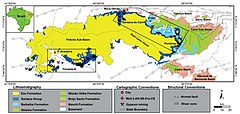| Crato Formation | |
|---|---|
| Stratigraphic range: Latest Aptian ~ | |
| Type | Geological formation |
| Unit of | Santana Group |
| Sub-units | Nova Olinda Member |
| Underlies | Romualdo & Ipubi Formations |
| Overlies | Barbalha Formation |
| Lithology | |
| Primary | Mudstone, limestone |
| Other | Siltstone |
| Location | |
| Coordinates | 7°06′S 39°42′W / 7.1°S 39.7°W |
| Approximate paleocoordinates | 8°36′S 8°00′W / 8.6°S 8.0°W |
| Region | |
| Country | |
| Extent | Araripe Basin |
| Type section | |
| Named for | Crato, Ceará |
 Extent of the Santana Group, to which the Crato Formation belongs, in blue | |
The Crato Formation is a geologic formation of Early Cretaceous (Aptian) age in northeastern Brazil's Araripe Basin. It is an important Lagerstätte (undisturbed fossil accumulation) for palaeontologists. The strata were laid down mostly during the Aptian age, about 113 million years ago. It thought to have been deposited in a semi-arid lacustrine wetland environment.[1]
The Crato Formation earns the designation of Lagerstätte due to an exceedingly well preserved and diverse fossil faunal assemblage. Some 25 species of fossil fishes are often found with stomach contents preserved, enabling paleontologists to study predator-prey relationships in this ecosystem. There are also fine examples of pterosaurs, reptiles and amphibians, invertebrates (particularly insects), and plants. Even dinosaurs are represented: a new maniraptor was described in 1996. The unusual taphonomy of the site resulted in limestone accretions that formed nodules around dead organisms, preserving even soft parts of their anatomy.
- ^ Ribeiro et al., 2021